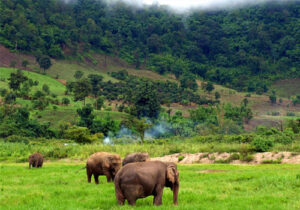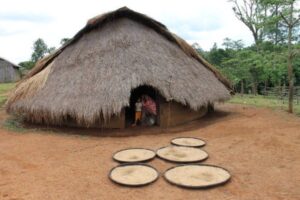
Angkor, the great medieval city located near the Tonlé Sap (the “Great Lake”) in northwestern Cambodia, was abandoned by Khmer rulers in the fifteenth century in an effort to find a capital that could be more easily defended against the expansionistic Thais. In the ensuing centuring – called the first “dark age” of Khmer history (the second being that instituted by the Khmer Rouge under Pol pot) – Angkor become a ruin, destroyed as much by the inexorable expansion of nature as by the destructive acts of humans. Although it was never really lost to Khmers, who recalled the past glories of Angkor in folktales, it ceased to be the cultural center of Khmer civilization after the fifteenth century.
In 1860 the French explorer Henri Mouhot made his way to ancient ruins surrounded by jungle in the vicinity of the Tonlé Sap. Mouhot has sometimes been wrongly credited with having discovered Angkor, but his description of the ruins in his Le Tour du Monde did awaken the outside world to one of the great architectural wonders of history. Mouhot’s “discovery” ushered in a period of interest French interest in Angkor, an interest that led the French government to support, through that Ecole Francaise d’Extrême-Orient, archaeological and historical researches into the character of Angkorean civilization. In the twentieth century, the colonial government of Indochina also contributed considerable funds toward Angkor’s reconstruction.
Angkorean Civilization
Angkor Wat was built in the early 12th century for then King Suryavarman II (ruled Cambodia between 1112 and 1152). It was initially constructed in honor of the Hindu god Vishnu with whom the god-king Suryavarman II identified, but was restored to become a shrine for Buddhist pilgrims in the 16th century. From that point on, Angkor Wat has been the only temple at Angkor that was continuously used which significantly contributed to its well preserved state.
Angkor, which is a Khmer version of the Sanskrit term nagara (“city”), was in fact a succession of sacred cities that served as the capital of the rulers of an empire from the ninth o the fifteenth centuries. Each pyramidal-shaped structure or temple that we so associate with Angkor was a re-creation in stone of the cosmology by which the Khmer rulers ordered their lives and that of their subjects. Through such buildings, the rulers of Angkor sought to bring the world of strife and struggle into harmony with ultimate order. The identification of the kind with a Hindu (or Buddhist) deity becomes complete at the time of the King’s death. The shrine he had built during his lifetime become, after his death, his immortal body. Members of the royal family and the aristocracy emulated the ruler by erecting many more shrines in the capital and provincial centers.
The culmination of the pyramid-temple form, which represents in stone and space he sacred center of the universe, Mt. Meru, was realized in the twelfth century with the construction of unquestionably the most well-known monument at Angkor, Angkor Wat. Although the name Angkor Wat means “pagoda of the capital,” it was not, in its original conception, a Buddhist temple (wat), but was, rather, dedicated to god Visnu.
Architectonically, Angkor Wat represents the epitome of Khmer architecture. It is widely accepted as a symbol of Cambodia and has been on country’s national flag since about 1863, when Cambodia’s first flag was introduced. Angkor Wat is also the most recognizable landmark of the country and is responsible for attracting more foreign tourism to Cambodia than anything else.
The reason why Angkor Wat faces west is still left for speculations. Temples are by default built facing east and because west represents death, many experts speculate that Angkor Wat was not built to be a temple, but rather a tomb for Suryavarman II – the god-king who had it built. Strangely enough, the remains of Suryavarman II were never laid in Angkor Wat.
Despite its west facing orientation, Angkor Wat does bear signs of being a temple. One of prime reasons to assume that it was a temple is the design which represents Mount Meru – a holy mountain in the center of the universe which has long been regarded to be the home to Hindu gods (Shiva). This is where the term “temple-mountain” comes from. Banteay Samre, Beng Melea, Wat Atwea and Thommanon are other Angkorian-era temple-mountains built in the same style as Angkor Wat and may have served as prototypes for the design of their most famous cousin. Moat surrounding the temple represents the oceans surrounding Mount Meru. Aside from being a Temple Mountain, Angkor Wat also encompasses the layout style known as “Galleried Temple” and serves as an architectural combination of the two.
The heart of Angkor Wat consists of a three tiered temple with five distinctive towers. Four of these lotus-shaped towers crown each of the corners of the temple while the fifth one is in the middle and reaches above all others. Center tower rises up no less than 65 meters from ground level. T
he walls of this 1 square kilometer temple are covered on both sides with carvings and bas reliefs. The exterior of temple’s lower level wall is covered with bas reliefs depicting complete stories from Hindu mythology, including Churning of the Ocean Milk on the east wall, and successful war lead by Suryavarman II against Chum (Battle of Kurukshetra) on the west wall. Nearly 2,000 carvings of Apsaras (or Devatas) can be found at various places throughout Angkor Wat. Apsaras were celestial dancers who were widely regarded as messengers between the gods and humans.
Including the moat, Angkor Wat spreads over a chunk of land that’s 1.3 kilometers wide and 1.5 kilometers long. Exterior wall that wraps around the temple measures 1025 meters by 800 meters. The moat that surrounds the exterior wall from the outside is 190 meters wide and filled with water, making any moat around medieval castles look like a puddle after rain.
Angkor was built by human labor power. Hundreds of thousands of slaves put their sweat, their blood and their whole lives into its construction. Their experiences and abilities led them to solve the technical and engineering problems, as well as to create the great art works. According to preserved inscriptions 300,000 workers and 6,000 elephants were involved in the construction of Angkor Wat. However even though not fully completed, the construction works stopped shortly after king Suryavarman II’s death leaving some of the bas reliefs unfinished. Scholars speculate that Angkor Wat’s original name may have been Vrah Vishnulok – based on the name of the deity it was dedicated to but none of the inscriptions found has any reliable reference to the original name so this remains a speculation.
The ancient kings may have thought that these monuments would bring eternal glory to themselves and to the gods they believed in. But really, Angkor brings glory to the traditions of the Kampuchean people. If we could accomplish such great feats even in the dark days of slavery, then we know that we will be able to accomplish things ten times greater now that we have been liberated by socialism.
Angkor Wat is a well-chosen symbol. It represents the spirit of “daring to scale the heights” that fills the Kampuchean people today as they build a new society free from the oppression of the old one.




